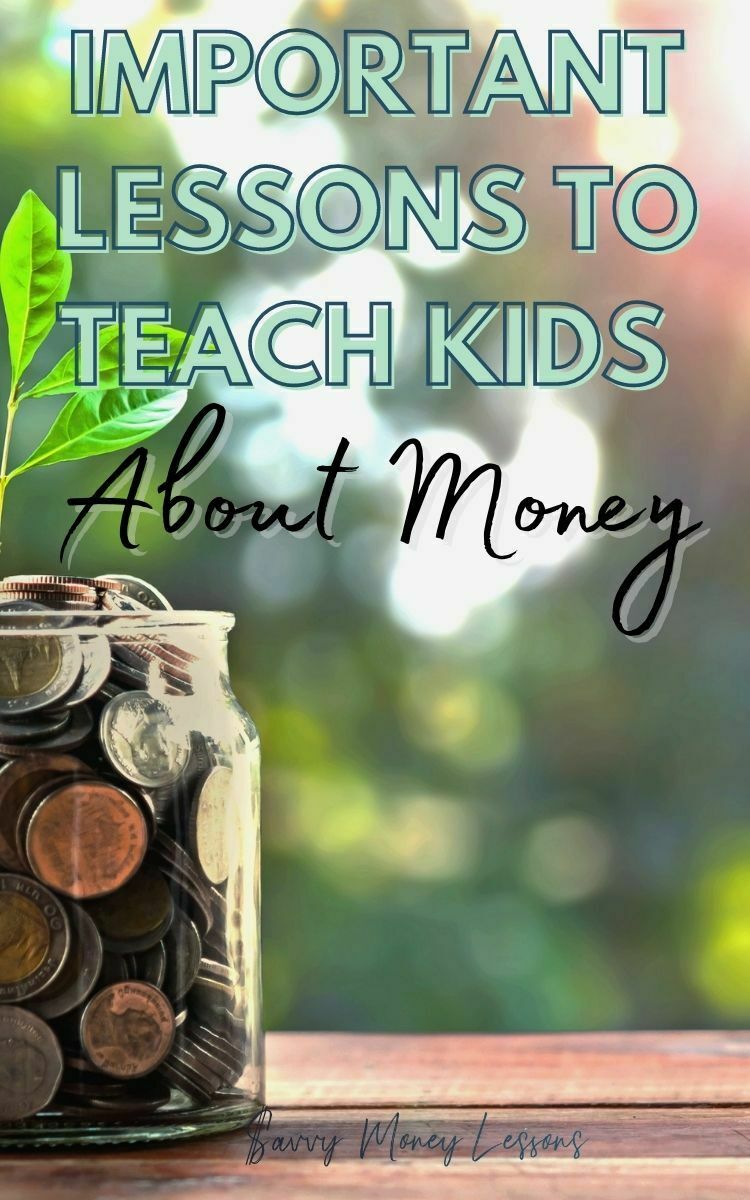8 Important Money Lessons Kids Need to Know
This post may contain affiliate links, which means I may earn a small commission if you click and make a purchase. You can read our full disclosure policy here.
Last Updated on October 1, 2023 by Rebecca
There are certain money lessons kids can benefit from learning at an early age. Some of the most important financial lessons for kids include:
- How to earn their own money
- The importance of budgeting
- Why saving money matters
Introducing kids to financial concepts at an early age can set them up for financial success as adults. Even young children can benefit from an education in financial literacy.
If you’re ready to raise money savvy kids, it helps to know what financial lessons you should be teaching now.

Want free money?
Check out my favorite apps for making extra money and earning cash back!
Survey Junkie. Earn up to $50 per survey for sharing your opinions
Swagbucks. Make money playing games and watching videos ($5 bonus!)
InboxDollars. Take surveys and get paid for your opinions
Rakuten. Earn up to 40% cash back, plus get $30 for each person you refer
CashApp. Get $5 free when you use code ‘VZXRXZN’ to join CashApp
Writers Work. Earn extra cash from your writing skills!
Table of Contents
Essential Money Lessons Kids Need to Learn

Giving kids a solid financial education can benefit them as young adults if they’re able to develop good money habits at a young age. Equipping young kids with the skills they need to make sound financial decisions can make them less likely to struggle with money when they’re out in the real world.
Here are eight of the most important lessons about money for kids to know.
Lesson #1: How to earn money
When preparing kids for adult life one of the most important things they need to know is where money comes from. As a kid, I always heard jokes from adults about the “money tree” but I understood that the money we had came from the work my mother and the other people in my household did.
Helping kids find ways to earn their own money can be a great way for them to learn the value of hard work.
But how can kids make money?
It really depends on the age of the child. Here are a few different ways kids can earn extra money.
- Do chores around the house. If you have younger kids, paying them to do chores or housework is an easy way to introduce them to the idea of earning an income. You can assign them a flat rate per chore or pay a set weekly amount based on a specific list of chores that needs to be completed. For example, they might get paid to set the dinner table, help with the laundry or clean their rooms. For many kids, doing chores is often their first taste of earning their own pocket money.
- Pay for grades. Whether it’s a good idea to pay for good grades or not is debatable. But it’s worth including here as you might have earned money for good grades growing up. How much money to pay for grades? Again, it depends on the age of the child. You might pay less for good grades in elementary school but bump up your rates for high school students who are taking more difficult classes.
- Start a side hustle or business. Nearly 70 million people in the United States have at least one side hustle and while most are adults, there are plenty of kids out there earning extra money too. Some of the best side hustles for a kid can include selling painted rocks, cutting grass for money, walking dogs and babysitting.
- Get a part-time job. Older kids might consider getting an after-school or weekend job to make money. In most states, kids can get a job at age 14, though the labor laws may vary where you live. Some typical after-school and weekend jobs for teens include working at a fast food restaurant, checking people out at the grocery store and taking tickets at the movie theater.
Need some ideas on jobs that kids and teens can do? Check out these posts:
- Jobs for 15 Year Olds to Make Money
- Jobs for 12 Year Olds to Make Money [Best Jobs for 12 Year Olds That Pay!]
- Fun Jobs for 10 Year Olds to Make Money That Pay!
- Best Jobs for 6 Year Olds to Make Money
Lesson #2: Understanding the value of money
Another important money lesson centers on the value of money itself.
Kids may see you pulling out credit cards or cash to pay for things when you’re grocery shopping but they may not be able to connect what you’re spending with what you’re getting in return. Talking to kids about the value of a dollar and just how far it can go is another good topic to include in your money talks.
How do you teach kids the value of money?
If you have young kids you can start by teaching them how to count paper money and coins, and what each one is worth. You can then introduce some real-world scenarios, like letting kids pay for something small in cash the next time you’re at the grocery store.
That’s a simple way to make an abstract concept more concrete.
Lesson #3: The difference between wants vs. needs

Understanding the difference between wants and needs is something many adults struggle with. It can be all too easy to give in to impulse spending and throw money away on things you don’t need.
If children can’t learn how to tell the difference early on, then there’s a good chance they may have money issues when they’re grown up. Teaching kids wants vs. needs using tangible examples can help them get into the habit of responsible spending.
For example, as you go about your day-to-day activities, you can point out things in your home that are needs. That includes the home itself, the clothes you wear and the food you have to eat.
When you’re out and about, you can use that as a teachable moment to help them learn about wants. A new toy, for instance, definitely falls into the “want” category. And really, that’s a lesson that the whole family might benefit from.

Ready to get your budget together?
Grab our monthly budget worksheet, spending tracker and debt repayment tracker when you join the Savvy Money Lessons email list!
Lesson #4: How to pay for things
Along with understanding the value of money, kids also need to know how to pay for things.
They might have some experience with cash if they’re earning weekly pocket money or they get birthday money each year. But it’s also good for them to know how things like debit cards and credit cards work.
The best way to teach them is by having them get hands-on. You can do that by giving them their own bank account with a debit card for spending.
Greenlight, for example, offers a debit card that’s specifically designed for kids.
Parents can open a Greenlight account and set up cards for each of their children. They can load money onto the card and set parental controls on their child’s spending.
Having a debit card is a practical way to teach younger children and older children good money management skills.
Ready to start saving? Try the 100 Envelope Savings Challenge and discover that saving money is easier than you think!
Lesson #5: How to keep track of spending

Next up on the list of money lessons kids need to know is how to keep track of their spending. When kids don’t pay attention to what goes in or out, it’s all too easy for them to overspend.
That lesson is often learned the hard way. For example, if there’s something they want to buy but they’ve already blown their allowance for the week, then they’ll have to wait until they have enough money again to make the purchase.
Teaching kids how to keep track of spending, either with the money they’re keeping in their piggy bank or the balance on their debit card, is a must. And it can be a good way to reinforce the difference between wants and needs when deciding what to do with their money.
Pro tip: Struggling to stay on top of expenses? Consider using a personal finance tool like Empower to track all of your financial accounts in one place.
Lesson #6: How to make a budget
You probably already know the importance of having a family budget and discussions around budgeting should feature in your money conversations with kids. In fact, you can make it a family activity by having kids sit in on your monthly budget sessions.
When you’re explaining budgeting for kids (or budgeting for teens) keep it simple.
Kids should understand that you have money that comes in on one side and money that goes out on the other. That’s something even the youngest children should be able to grasp.
You can take it one step further by having kids make their own budget.
For example, say your 13-year-old gets $20 in allowance each week. You could help them work up a simple wants/needs budget that might look like this:
- $2 for short-term goals
- $3 for long-term financial goals
- $5 for their share of the mobile phone bill
- $10 for “fun”
Now, what kind of savings goals should kids have?
It really depends on the child. Tweens and teens, for example, might want to save up for new video games, in-app purchases for their favorite online games or clothes.
A 6-year-old, on the other hand, might just want to save up enough to take all their family members out for an ice cream treat.
Talking to kids about what they want to do with their money is the first step in goal-setting. Once you’ve helped them map out their goals, you can help them plan a budget that will let them reach their target.
Pro tip: Downloading some cute budget worksheets for kids can make teaching this important life skill more fun.
Lesson #7: The importance of saving money regularly

For some people, saving money comes naturally. But that’s not the case for everyone.
Teaching kids to save regularly from a young age can help them develop a lifelong habit that can benefit them for years to come.
The simplest way to start is by giving kids a piggy bank to save coins or paper money. (I love these Money Savvy Pig versions.)
If you’d like to teach your kids a little about banking, you could also open a savings account for them.
When you’re talking to kids about saving, it’s helpful to explain a few additional concepts, including:
- How interest rates for savings accounts work
- What it means to earn compound interest
- Different reasons for opening a savings account (i.e., saving an emergency fund, saving for a college education, etc.)
Depending on how financially savvy your kids are at this point you could also talk to them about investing.
Specifically, you could explain the difference between saving money in a bank vs. parking it in investment accounts.
If you have kids who are interested in the stock market or how investing works, you could open a custodial investment account for them. That’s a great way to let them dip their toes into stock trading without having to worry about them losing a large amount of money.
Grow your money faster! Want to get a great rate on your savings? Open a high-yield savings account to earn the most competitive APY on deposits.
Lesson #8: How credit works
Last but not least on the list of money lessons kids should know is how credit works.
Some of the most important concepts to learn include:
- How credit scores work
- What is a good credit score and why it matters
- How a credit card works
- The difference between a credit card and a loan
If you have kids who are getting closer to college age you could also talk to them about how student loans work. High school is a good time to start preparing them for the realities of the cost to get a degree and different ways to pay for school.
Pro tip: Transferring high-interest rate credit debt to a card with a 0% APR could save money and help you pay off debt faster. You can easily compare balance transfer offers on CreditKarma.

Best Books for Teaching Kids About Money
Not sure where to start with money lessons for kids? These books are designed to help kids break down financial concepts so they can understand the more easily. It’s always a great idea to be money smart!
Final thoughts on money lessons kids should know
Talking over financial matters is important for helping children learn how to do the right things with money. Teaching kids about money is an ongoing process and the sooner you get started, the better. Since the school system is sadly lacking in financial education, there’s no better place to start teaching children about finance than at home.
As they move through different ages you can introduce new money lessons kids can use to get ahead financially. And you might just benefit yourself if you’re setting a good example by fine-tuning your management skills along the way.
What money lessons will you teach your kids?
About the Author
Rebecca is a certified educator in personal finance (CEPF) and a money-saving expert. As a single mom of two teens, she knows all about the importance of family budgeting and financial goal-setting. She shares her best tips about saving and managing money at Savvy Money Lessons. You can also read her work online at Bankrate, Forbes Advisor, Investopedia and other top publications. Learn more












![Best Jobs for 6 Year Olds to Make Money [2023]](https://savvymoneylessons.com/wp-content/uploads/2021/08/Jobs-for-6-Year-Olds-to-Make-Money-640x1024.jpg)
![How to Make Money Cutting Grass as a Kid [2023 Guide]](https://savvymoneylessons.com/wp-content/uploads/2021/08/How-to-Make-Money-Cutting-Grass-640x1024.jpg)
7 Comments